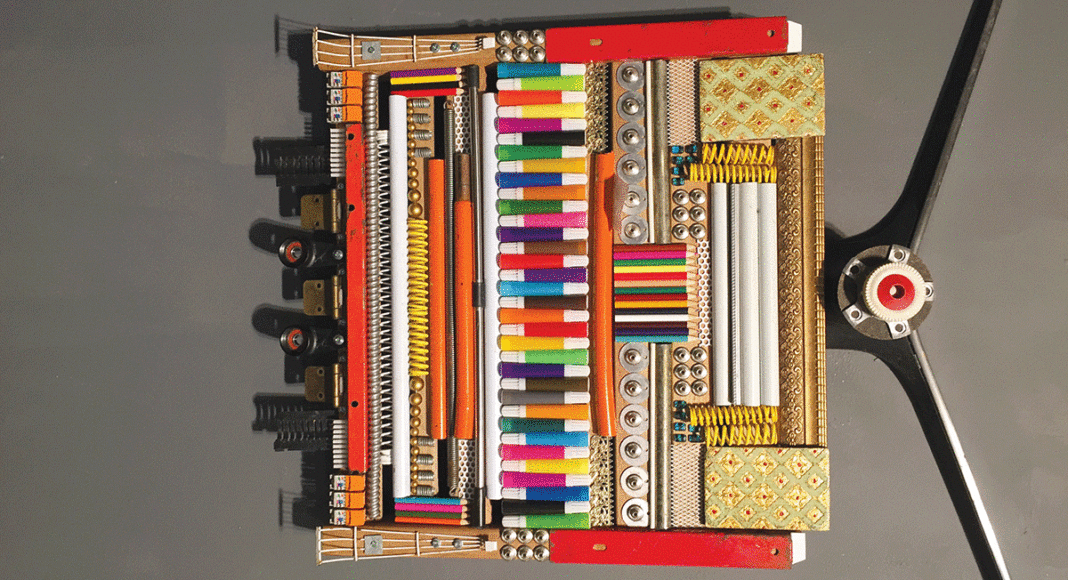As far as places to score art materials go, the city of Santa Cruz’s Resource Recovery Facility—known forever and always to locals as “the dump”—is never going to be mistaken for Lenz Arts.
It’s loud, dusty and windswept. There are large, dangerous machines about. The CalTrans-orange vests you have to wear are flattering to no one. And frankly, it’s on the way to nowhere, a long haul for just about anyone in Santa Cruz County.
But soon the place is bound to be crawling with artists—and not just because of those famously scenic ocean views.
The landfill located just west of the entrance to Wilder Ranch State Park is the focus of a city program known as SCRAP (Santa Cruz Recycled Art Program) in which artists of all kinds are encouraged to forage for thrown-out materials to remake them into … well, anything. Through a formal application process, the program appoints about a half-dozen artists every year and grants them access to the wealth of materials at the landfill and recycling center—metal, wood, plastic, textiles, electronics, whole artifacts or pieces of them, almost any non-hazardous material.
After several months of visiting the landfill, the SCRAP artists will unveil their artistic expression to the world with a show at the R. Blitzer Gallery in Santa Cruz.
The program is in its fourth year, and many of the artists who participated in its first three years are exhibiting their work this month at the Felix Kulpa Gallery and Habitat for Humanity’s ReStore facility on Swift Street. The exhibits are designed to draw attention to the fast-approaching deadline (July 1) for artists to apply for round four.
Mary Tartaro is the program’s coordinator and a mixed-media found-object sculptor in her own right. Her sculpture Redeemer is a kind of feminist answer to the famous Christ the Redeemer statue that looms over Rio de Janeiro. But Tartaro’s piece is composed entirely of stuff other people had thrown away. She’s eager to invite as many artists as possible to apply for the program, urging artists to think not just outside the box, but outside the building.
Tartaro says she’d encourage people not to look at the work of past SCRAP artists as a template for what is expected or acceptable. “I would tell people to take it in a direction where it’s never gone,” she says. “What if someone’s media is performance art? Or video? What if there’s no physical object involved?”
Even if there are no artistic rules, there are plenty of ground rules at the recycling facility. During a recent tour of the landfill, site superintendent Craig Pearson welcomed artists and praised the program but repeated four times within as many minutes: “I am responsible for your safety.”
Chosen artists will be expected to behave safely and conscientiously at the site, to check in with the staff, be aware of their surroundings and stay away from places where they don’t belong, says Pearson.
With the familiar beep-beep-beep of heavy machinery hanging in the air, artists followed along as Tartaro and Beth Tobey, the city of Santa Cruz’s arts program manager, escorted prospective program artists around the site among the trucks, loaders and forklifts.
Each of the artists has their own approach and interests. Pam Dewey of Santa Cruz, for example, has dedicated much of her artistic efforts to quilting. And if the design of her quilts are more or less traditional, the materials definitely are not. She is almost certainly the only person in Santa Cruz County that has a quilt on her wall made from the skin of smoked turkeys. “I used to live in New York,” she says, “and I would always be pulling things off the street. Quilts are all about recycling. For me, it’s all about reusing things with a history.”
Artists also learned basic strategies for how to score the best stuff—come on Saturdays and Mondays, for instance, when most people come to dump unwanted materials—and to hang around, be patient or even offer to help people unload their cars and trucks.
Tartaro says she would like to see some of the artists take on pieces that serve an environmental or social-action purpose. Using such recycled materials and having this kind of access to the waste stream is, she believes, a good opportunity to make some kind of comment about overconsumption.
“It’s sad sometimes when you go out there and see what kind of materials come in. You’re like, why are you throwing that away?” Tartaro says. “We’re all just so pressed for time. And that’s because we all have jobs so we can buy more stuff that will soon become trash. You start to ask, ‘Why do we need all this stuff?’”












